Construction Law: Pure Economic Losses and Collateral Warranties
VerifiedAdded on 2022/10/15
|7
|1864
|10
Essay
AI Summary
This essay critically analyzes the recoverability of pure economic losses under tort law within the context of construction law. It defines pure economic losses and distinguishes them from physical or property damage, examining the historical conflict in legal decisions regarding their recoverability. The essay explores the relationship between contractual obligations and the duty of care of contractors, referencing key cases such as Robinson v P.E. Jones (Contractors) Ltd and Murphy v Brentwood District Council. It delves into the concept of collateral warranties, discussing their role in addressing losses beyond the scope of standard contracts, and analyzes cases like Scottish Widows Services & Anor v Harmon/CRM Facades Ltd and D&F Estates Ltd v Church Commissioners for England and Wales. The essay concludes that for the recovery of pure economic losses in construction, both contractual obligations and a duty of care under tort law must be established, highlighting the significance of collateral warranties in actionable cases of negligence.
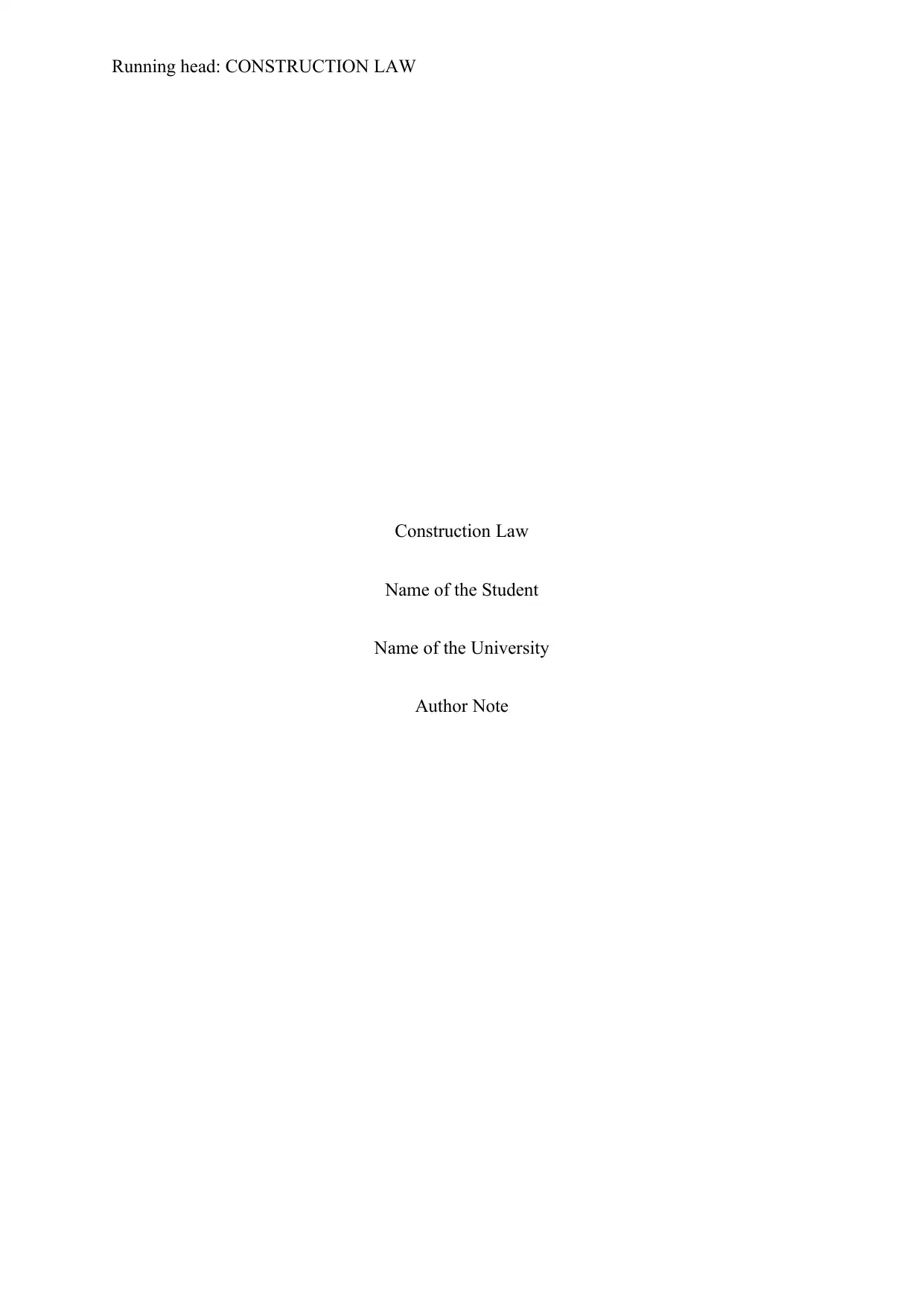
Running head: CONSTRUCTION LAW
Construction Law
Name of the Student
Name of the University
Author Note
Construction Law
Name of the Student
Name of the University
Author Note
Paraphrase This Document
Need a fresh take? Get an instant paraphrase of this document with our AI Paraphraser
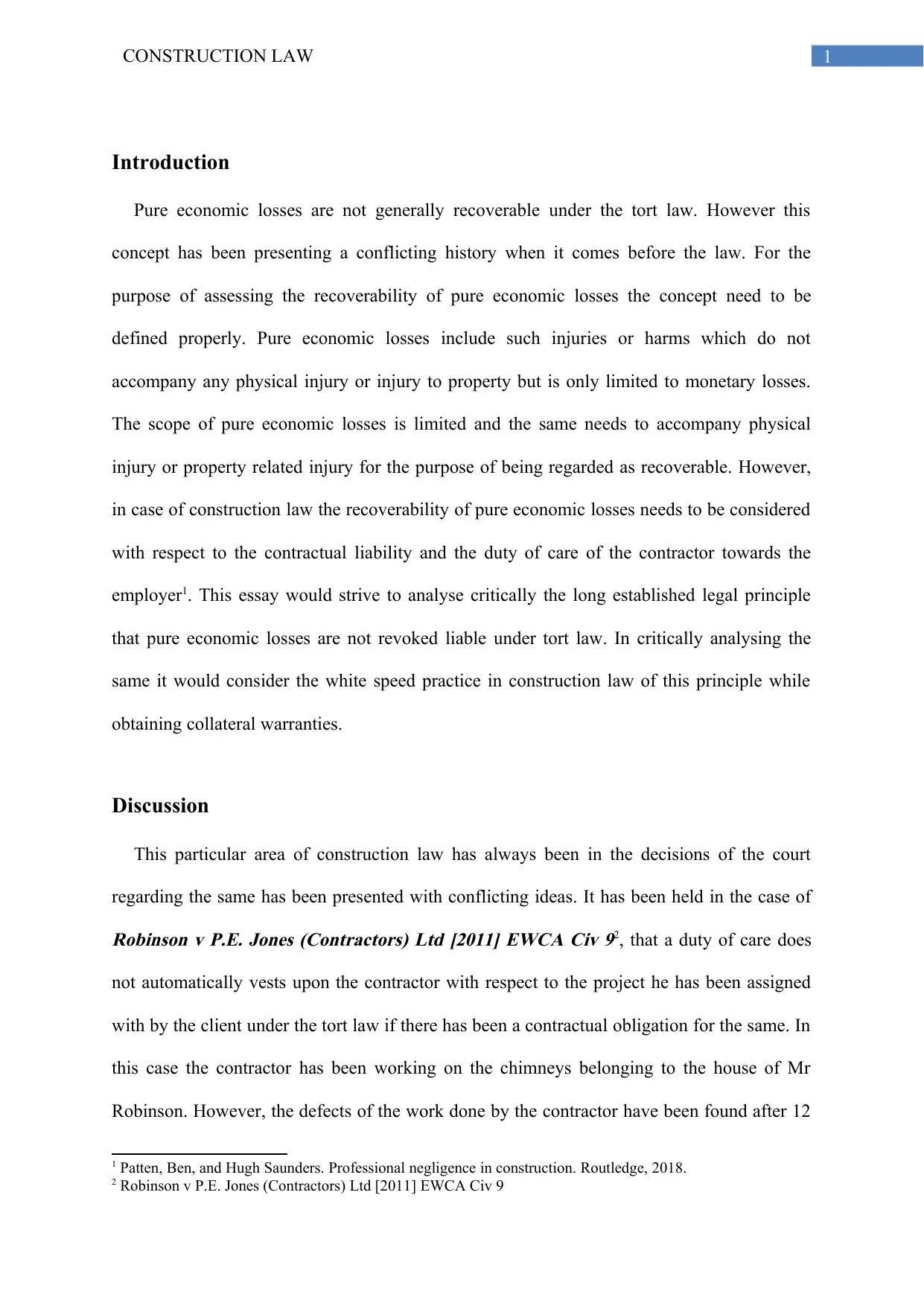
1CONSTRUCTION LAW
Introduction
Pure economic losses are not generally recoverable under the tort law. However this
concept has been presenting a conflicting history when it comes before the law. For the
purpose of assessing the recoverability of pure economic losses the concept need to be
defined properly. Pure economic losses include such injuries or harms which do not
accompany any physical injury or injury to property but is only limited to monetary losses.
The scope of pure economic losses is limited and the same needs to accompany physical
injury or property related injury for the purpose of being regarded as recoverable. However,
in case of construction law the recoverability of pure economic losses needs to be considered
with respect to the contractual liability and the duty of care of the contractor towards the
employer1. This essay would strive to analyse critically the long established legal principle
that pure economic losses are not revoked liable under tort law. In critically analysing the
same it would consider the white speed practice in construction law of this principle while
obtaining collateral warranties.
Discussion
This particular area of construction law has always been in the decisions of the court
regarding the same has been presented with conflicting ideas. It has been held in the case of
Robinson v P.E. Jones (Contractors) Ltd [2011] EWCA Civ 92, that a duty of care does
not automatically vests upon the contractor with respect to the project he has been assigned
with by the client under the tort law if there has been a contractual obligation for the same. In
this case the contractor has been working on the chimneys belonging to the house of Mr
Robinson. However, the defects of the work done by the contractor have been found after 12
1 Patten, Ben, and Hugh Saunders. Professional negligence in construction. Routledge, 2018.
2 Robinson v P.E. Jones (Contractors) Ltd [2011] EWCA Civ 9
Introduction
Pure economic losses are not generally recoverable under the tort law. However this
concept has been presenting a conflicting history when it comes before the law. For the
purpose of assessing the recoverability of pure economic losses the concept need to be
defined properly. Pure economic losses include such injuries or harms which do not
accompany any physical injury or injury to property but is only limited to monetary losses.
The scope of pure economic losses is limited and the same needs to accompany physical
injury or property related injury for the purpose of being regarded as recoverable. However,
in case of construction law the recoverability of pure economic losses needs to be considered
with respect to the contractual liability and the duty of care of the contractor towards the
employer1. This essay would strive to analyse critically the long established legal principle
that pure economic losses are not revoked liable under tort law. In critically analysing the
same it would consider the white speed practice in construction law of this principle while
obtaining collateral warranties.
Discussion
This particular area of construction law has always been in the decisions of the court
regarding the same has been presented with conflicting ideas. It has been held in the case of
Robinson v P.E. Jones (Contractors) Ltd [2011] EWCA Civ 92, that a duty of care does
not automatically vests upon the contractor with respect to the project he has been assigned
with by the client under the tort law if there has been a contractual obligation for the same. In
this case the contractor has been working on the chimneys belonging to the house of Mr
Robinson. However, the defects of the work done by the contractor have been found after 12
1 Patten, Ben, and Hugh Saunders. Professional negligence in construction. Routledge, 2018.
2 Robinson v P.E. Jones (Contractors) Ltd [2011] EWCA Civ 9
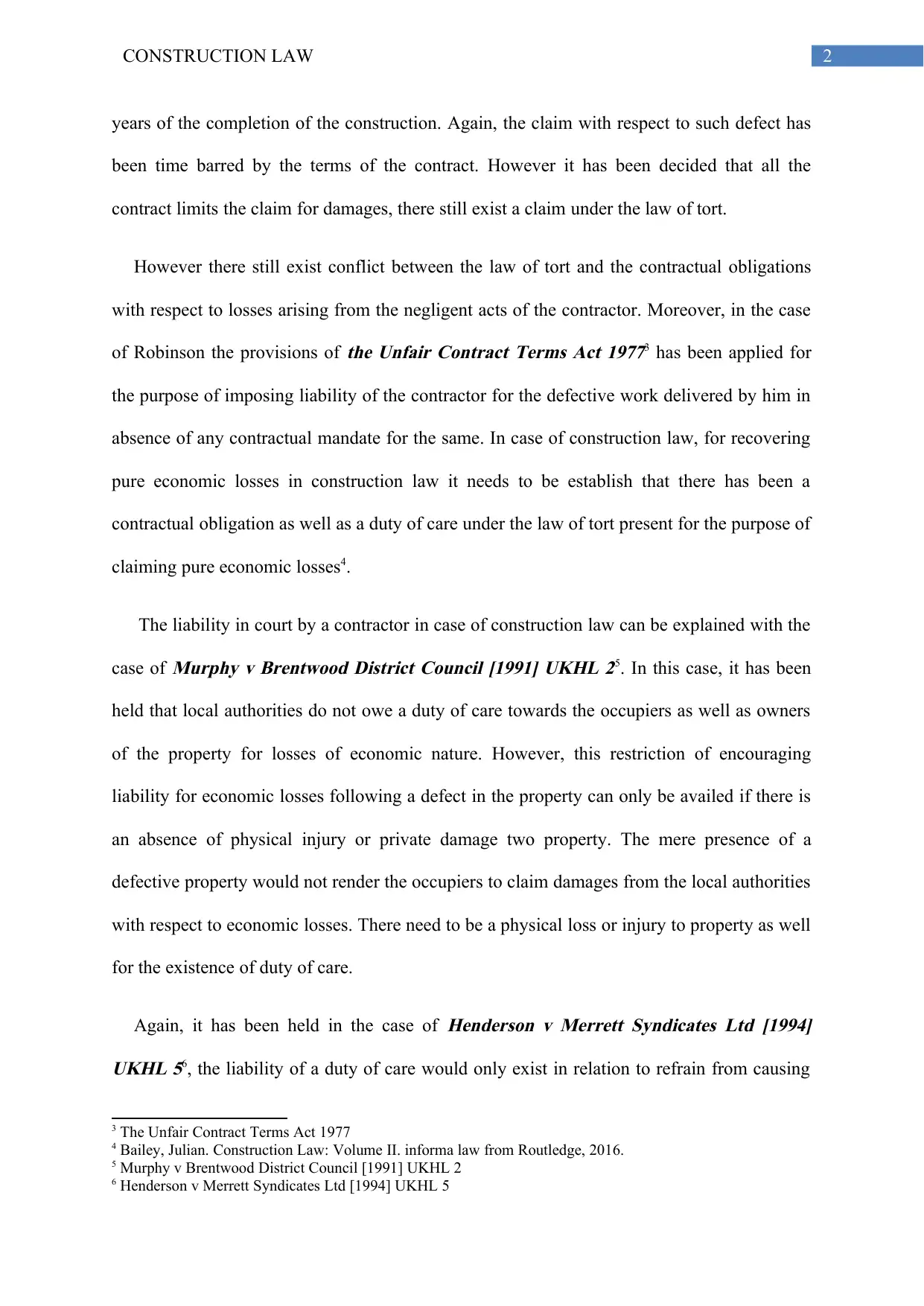
2CONSTRUCTION LAW
years of the completion of the construction. Again, the claim with respect to such defect has
been time barred by the terms of the contract. However it has been decided that all the
contract limits the claim for damages, there still exist a claim under the law of tort.
However there still exist conflict between the law of tort and the contractual obligations
with respect to losses arising from the negligent acts of the contractor. Moreover, in the case
of Robinson the provisions of
the Unfair Contract Terms Act 19773 has been applied for
the purpose of imposing liability of the contractor for the defective work delivered by him in
absence of any contractual mandate for the same. In case of construction law, for recovering
pure economic losses in construction law it needs to be establish that there has been a
contractual obligation as well as a duty of care under the law of tort present for the purpose of
claiming pure economic losses4.
The liability in court by a contractor in case of construction law can be explained with the
case of
Murphy v Brentwood District Council [1991] UKHL 25. In this case, it has been
held that local authorities do not owe a duty of care towards the occupiers as well as owners
of the property for losses of economic nature. However, this restriction of encouraging
liability for economic losses following a defect in the property can only be availed if there is
an absence of physical injury or private damage two property. The mere presence of a
defective property would not render the occupiers to claim damages from the local authorities
with respect to economic losses. There need to be a physical loss or injury to property as well
for the existence of duty of care.
Again, it has been held in the case of
Henderson v Merrett Syndicates Ltd [1994]
UKHL 56, the liability of a duty of care would only exist in relation to refrain from causing
3 The Unfair Contract Terms Act 1977
4 Bailey, Julian. Construction Law: Volume II. informa law from Routledge, 2016.
5 Murphy v Brentwood District Council [1991] UKHL 2
6 Henderson v Merrett Syndicates Ltd [1994] UKHL 5
years of the completion of the construction. Again, the claim with respect to such defect has
been time barred by the terms of the contract. However it has been decided that all the
contract limits the claim for damages, there still exist a claim under the law of tort.
However there still exist conflict between the law of tort and the contractual obligations
with respect to losses arising from the negligent acts of the contractor. Moreover, in the case
of Robinson the provisions of
the Unfair Contract Terms Act 19773 has been applied for
the purpose of imposing liability of the contractor for the defective work delivered by him in
absence of any contractual mandate for the same. In case of construction law, for recovering
pure economic losses in construction law it needs to be establish that there has been a
contractual obligation as well as a duty of care under the law of tort present for the purpose of
claiming pure economic losses4.
The liability in court by a contractor in case of construction law can be explained with the
case of
Murphy v Brentwood District Council [1991] UKHL 25. In this case, it has been
held that local authorities do not owe a duty of care towards the occupiers as well as owners
of the property for losses of economic nature. However, this restriction of encouraging
liability for economic losses following a defect in the property can only be availed if there is
an absence of physical injury or private damage two property. The mere presence of a
defective property would not render the occupiers to claim damages from the local authorities
with respect to economic losses. There need to be a physical loss or injury to property as well
for the existence of duty of care.
Again, it has been held in the case of
Henderson v Merrett Syndicates Ltd [1994]
UKHL 56, the liability of a duty of care would only exist in relation to refrain from causing
3 The Unfair Contract Terms Act 1977
4 Bailey, Julian. Construction Law: Volume II. informa law from Routledge, 2016.
5 Murphy v Brentwood District Council [1991] UKHL 2
6 Henderson v Merrett Syndicates Ltd [1994] UKHL 5
⊘ This is a preview!⊘
Do you want full access?
Subscribe today to unlock all pages.

Trusted by 1+ million students worldwide
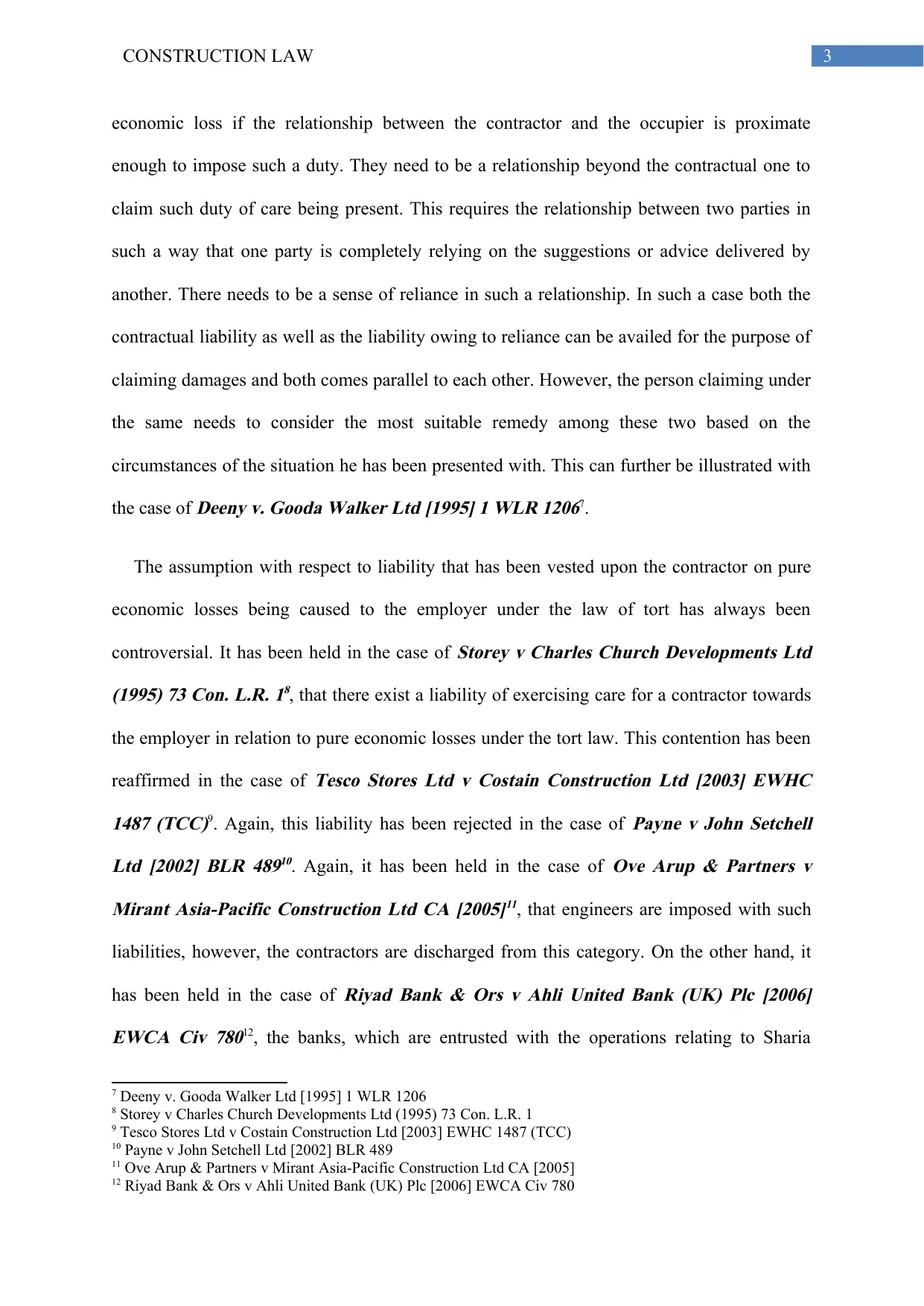
3CONSTRUCTION LAW
economic loss if the relationship between the contractor and the occupier is proximate
enough to impose such a duty. They need to be a relationship beyond the contractual one to
claim such duty of care being present. This requires the relationship between two parties in
such a way that one party is completely relying on the suggestions or advice delivered by
another. There needs to be a sense of reliance in such a relationship. In such a case both the
contractual liability as well as the liability owing to reliance can be availed for the purpose of
claiming damages and both comes parallel to each other. However, the person claiming under
the same needs to consider the most suitable remedy among these two based on the
circumstances of the situation he has been presented with. This can further be illustrated with
the case of
Deeny v. Gooda Walker Ltd [1995] 1 WLR 12067.
The assumption with respect to liability that has been vested upon the contractor on pure
economic losses being caused to the employer under the law of tort has always been
controversial. It has been held in the case of
Storey v Charles Church Developments Ltd
(1995) 73 Con. L.R. 18, that there exist a liability of exercising care for a contractor towards
the employer in relation to pure economic losses under the tort law. This contention has been
reaffirmed in the case of
Tesco Stores Ltd v Costain Construction Ltd [2003] EWHC
1487 (TCC)9. Again, this liability has been rejected in the case of
Payne v John Setchell
Ltd [2002] BLR 48910. Again, it has been held in the case of
Ove Arup & Partners v
Mirant Asia-Pacific Construction Ltd CA [2005]11, that engineers are imposed with such
liabilities, however, the contractors are discharged from this category. On the other hand, it
has been held in the case of
Riyad Bank & Ors v Ahli United Bank (UK) Plc [2006]
EWCA Civ 78012, the banks, which are entrusted with the operations relating to Sharia
7 Deeny v. Gooda Walker Ltd [1995] 1 WLR 1206
8 Storey v Charles Church Developments Ltd (1995) 73 Con. L.R. 1
9 Tesco Stores Ltd v Costain Construction Ltd [2003] EWHC 1487 (TCC)
10 Payne v John Setchell Ltd [2002] BLR 489
11 Ove Arup & Partners v Mirant Asia-Pacific Construction Ltd CA [2005]
12 Riyad Bank & Ors v Ahli United Bank (UK) Plc [2006] EWCA Civ 780
economic loss if the relationship between the contractor and the occupier is proximate
enough to impose such a duty. They need to be a relationship beyond the contractual one to
claim such duty of care being present. This requires the relationship between two parties in
such a way that one party is completely relying on the suggestions or advice delivered by
another. There needs to be a sense of reliance in such a relationship. In such a case both the
contractual liability as well as the liability owing to reliance can be availed for the purpose of
claiming damages and both comes parallel to each other. However, the person claiming under
the same needs to consider the most suitable remedy among these two based on the
circumstances of the situation he has been presented with. This can further be illustrated with
the case of
Deeny v. Gooda Walker Ltd [1995] 1 WLR 12067.
The assumption with respect to liability that has been vested upon the contractor on pure
economic losses being caused to the employer under the law of tort has always been
controversial. It has been held in the case of
Storey v Charles Church Developments Ltd
(1995) 73 Con. L.R. 18, that there exist a liability of exercising care for a contractor towards
the employer in relation to pure economic losses under the tort law. This contention has been
reaffirmed in the case of
Tesco Stores Ltd v Costain Construction Ltd [2003] EWHC
1487 (TCC)9. Again, this liability has been rejected in the case of
Payne v John Setchell
Ltd [2002] BLR 48910. Again, it has been held in the case of
Ove Arup & Partners v
Mirant Asia-Pacific Construction Ltd CA [2005]11, that engineers are imposed with such
liabilities, however, the contractors are discharged from this category. On the other hand, it
has been held in the case of
Riyad Bank & Ors v Ahli United Bank (UK) Plc [2006]
EWCA Civ 78012, the banks, which are entrusted with the operations relating to Sharia
7 Deeny v. Gooda Walker Ltd [1995] 1 WLR 1206
8 Storey v Charles Church Developments Ltd (1995) 73 Con. L.R. 1
9 Tesco Stores Ltd v Costain Construction Ltd [2003] EWHC 1487 (TCC)
10 Payne v John Setchell Ltd [2002] BLR 489
11 Ove Arup & Partners v Mirant Asia-Pacific Construction Ltd CA [2005]
12 Riyad Bank & Ors v Ahli United Bank (UK) Plc [2006] EWCA Civ 780
Paraphrase This Document
Need a fresh take? Get an instant paraphrase of this document with our AI Paraphraser
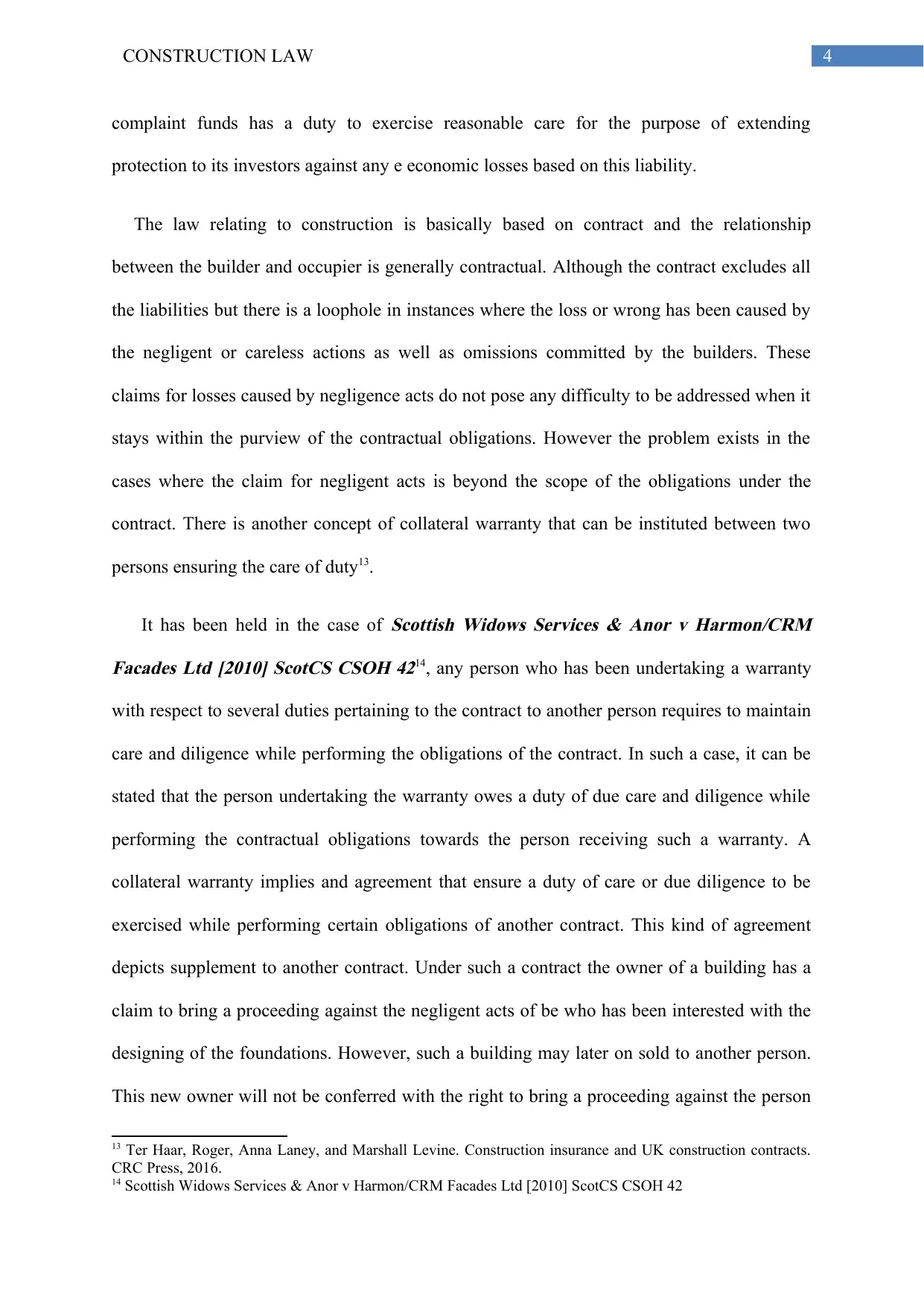
4CONSTRUCTION LAW
complaint funds has a duty to exercise reasonable care for the purpose of extending
protection to its investors against any e economic losses based on this liability.
The law relating to construction is basically based on contract and the relationship
between the builder and occupier is generally contractual. Although the contract excludes all
the liabilities but there is a loophole in instances where the loss or wrong has been caused by
the negligent or careless actions as well as omissions committed by the builders. These
claims for losses caused by negligence acts do not pose any difficulty to be addressed when it
stays within the purview of the contractual obligations. However the problem exists in the
cases where the claim for negligent acts is beyond the scope of the obligations under the
contract. There is another concept of collateral warranty that can be instituted between two
persons ensuring the care of duty13.
It has been held in the case of
Scottish Widows Services & Anor v Harmon/CRM
Facades Ltd [2010] ScotCS CSOH 4214, any person who has been undertaking a warranty
with respect to several duties pertaining to the contract to another person requires to maintain
care and diligence while performing the obligations of the contract. In such a case, it can be
stated that the person undertaking the warranty owes a duty of due care and diligence while
performing the contractual obligations towards the person receiving such a warranty. A
collateral warranty implies and agreement that ensure a duty of care or due diligence to be
exercised while performing certain obligations of another contract. This kind of agreement
depicts supplement to another contract. Under such a contract the owner of a building has a
claim to bring a proceeding against the negligent acts of be who has been interested with the
designing of the foundations. However, such a building may later on sold to another person.
This new owner will not be conferred with the right to bring a proceeding against the person
13 Ter Haar, Roger, Anna Laney, and Marshall Levine. Construction insurance and UK construction contracts.
CRC Press, 2016.
14 Scottish Widows Services & Anor v Harmon/CRM Facades Ltd [2010] ScotCS CSOH 42
complaint funds has a duty to exercise reasonable care for the purpose of extending
protection to its investors against any e economic losses based on this liability.
The law relating to construction is basically based on contract and the relationship
between the builder and occupier is generally contractual. Although the contract excludes all
the liabilities but there is a loophole in instances where the loss or wrong has been caused by
the negligent or careless actions as well as omissions committed by the builders. These
claims for losses caused by negligence acts do not pose any difficulty to be addressed when it
stays within the purview of the contractual obligations. However the problem exists in the
cases where the claim for negligent acts is beyond the scope of the obligations under the
contract. There is another concept of collateral warranty that can be instituted between two
persons ensuring the care of duty13.
It has been held in the case of
Scottish Widows Services & Anor v Harmon/CRM
Facades Ltd [2010] ScotCS CSOH 4214, any person who has been undertaking a warranty
with respect to several duties pertaining to the contract to another person requires to maintain
care and diligence while performing the obligations of the contract. In such a case, it can be
stated that the person undertaking the warranty owes a duty of due care and diligence while
performing the contractual obligations towards the person receiving such a warranty. A
collateral warranty implies and agreement that ensure a duty of care or due diligence to be
exercised while performing certain obligations of another contract. This kind of agreement
depicts supplement to another contract. Under such a contract the owner of a building has a
claim to bring a proceeding against the negligent acts of be who has been interested with the
designing of the foundations. However, such a building may later on sold to another person.
This new owner will not be conferred with the right to bring a proceeding against the person
13 Ter Haar, Roger, Anna Laney, and Marshall Levine. Construction insurance and UK construction contracts.
CRC Press, 2016.
14 Scottish Widows Services & Anor v Harmon/CRM Facades Ltd [2010] ScotCS CSOH 42
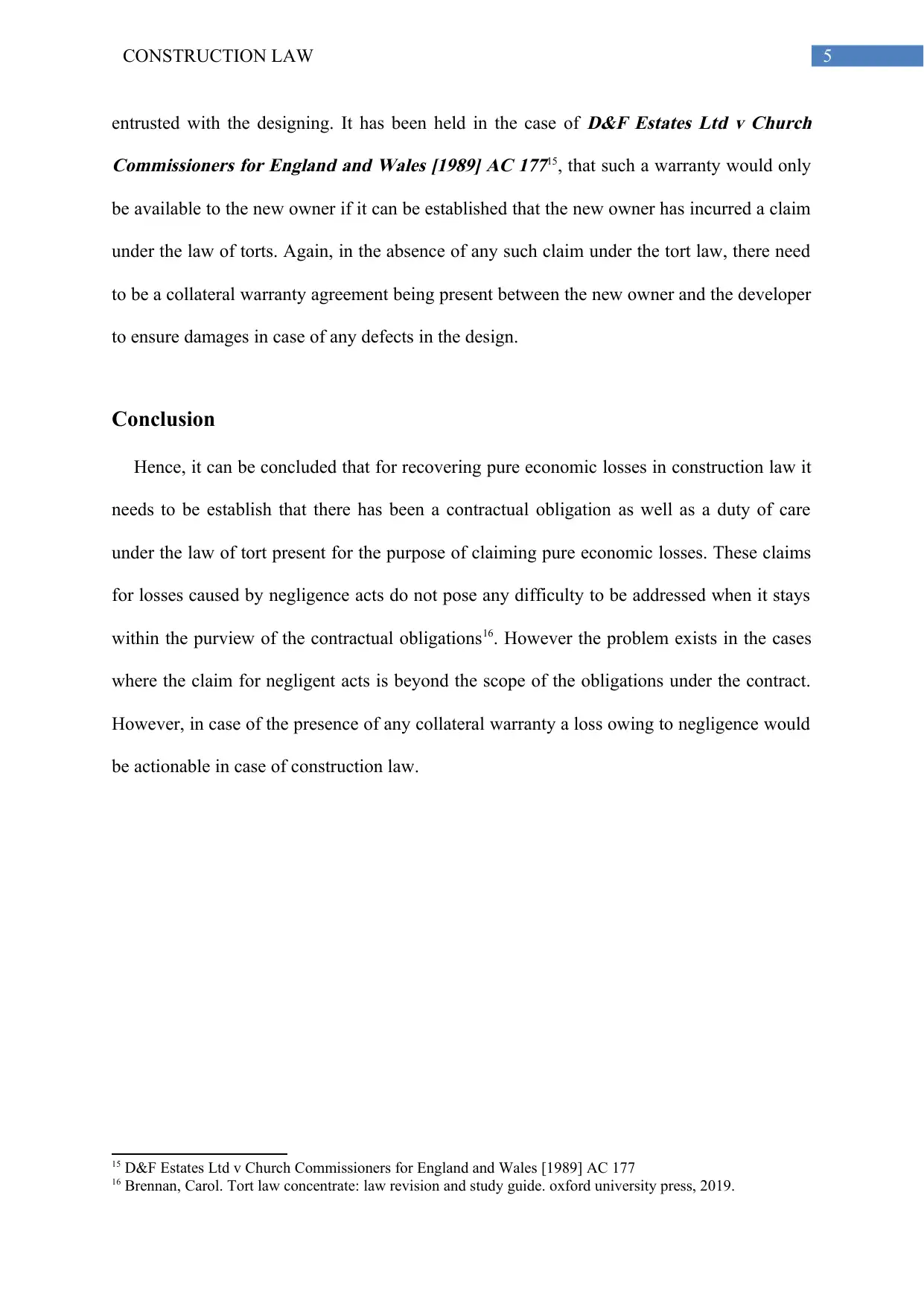
5CONSTRUCTION LAW
entrusted with the designing. It has been held in the case of
D&F Estates Ltd v Church
Commissioners for England and Wales [1989] AC 17715, that such a warranty would only
be available to the new owner if it can be established that the new owner has incurred a claim
under the law of torts. Again, in the absence of any such claim under the tort law, there need
to be a collateral warranty agreement being present between the new owner and the developer
to ensure damages in case of any defects in the design.
Conclusion
Hence, it can be concluded that for recovering pure economic losses in construction law it
needs to be establish that there has been a contractual obligation as well as a duty of care
under the law of tort present for the purpose of claiming pure economic losses. These claims
for losses caused by negligence acts do not pose any difficulty to be addressed when it stays
within the purview of the contractual obligations16. However the problem exists in the cases
where the claim for negligent acts is beyond the scope of the obligations under the contract.
However, in case of the presence of any collateral warranty a loss owing to negligence would
be actionable in case of construction law.
15 D&F Estates Ltd v Church Commissioners for England and Wales [1989] AC 177
16 Brennan, Carol. Tort law concentrate: law revision and study guide. oxford university press, 2019.
entrusted with the designing. It has been held in the case of
D&F Estates Ltd v Church
Commissioners for England and Wales [1989] AC 17715, that such a warranty would only
be available to the new owner if it can be established that the new owner has incurred a claim
under the law of torts. Again, in the absence of any such claim under the tort law, there need
to be a collateral warranty agreement being present between the new owner and the developer
to ensure damages in case of any defects in the design.
Conclusion
Hence, it can be concluded that for recovering pure economic losses in construction law it
needs to be establish that there has been a contractual obligation as well as a duty of care
under the law of tort present for the purpose of claiming pure economic losses. These claims
for losses caused by negligence acts do not pose any difficulty to be addressed when it stays
within the purview of the contractual obligations16. However the problem exists in the cases
where the claim for negligent acts is beyond the scope of the obligations under the contract.
However, in case of the presence of any collateral warranty a loss owing to negligence would
be actionable in case of construction law.
15 D&F Estates Ltd v Church Commissioners for England and Wales [1989] AC 177
16 Brennan, Carol. Tort law concentrate: law revision and study guide. oxford university press, 2019.
⊘ This is a preview!⊘
Do you want full access?
Subscribe today to unlock all pages.

Trusted by 1+ million students worldwide
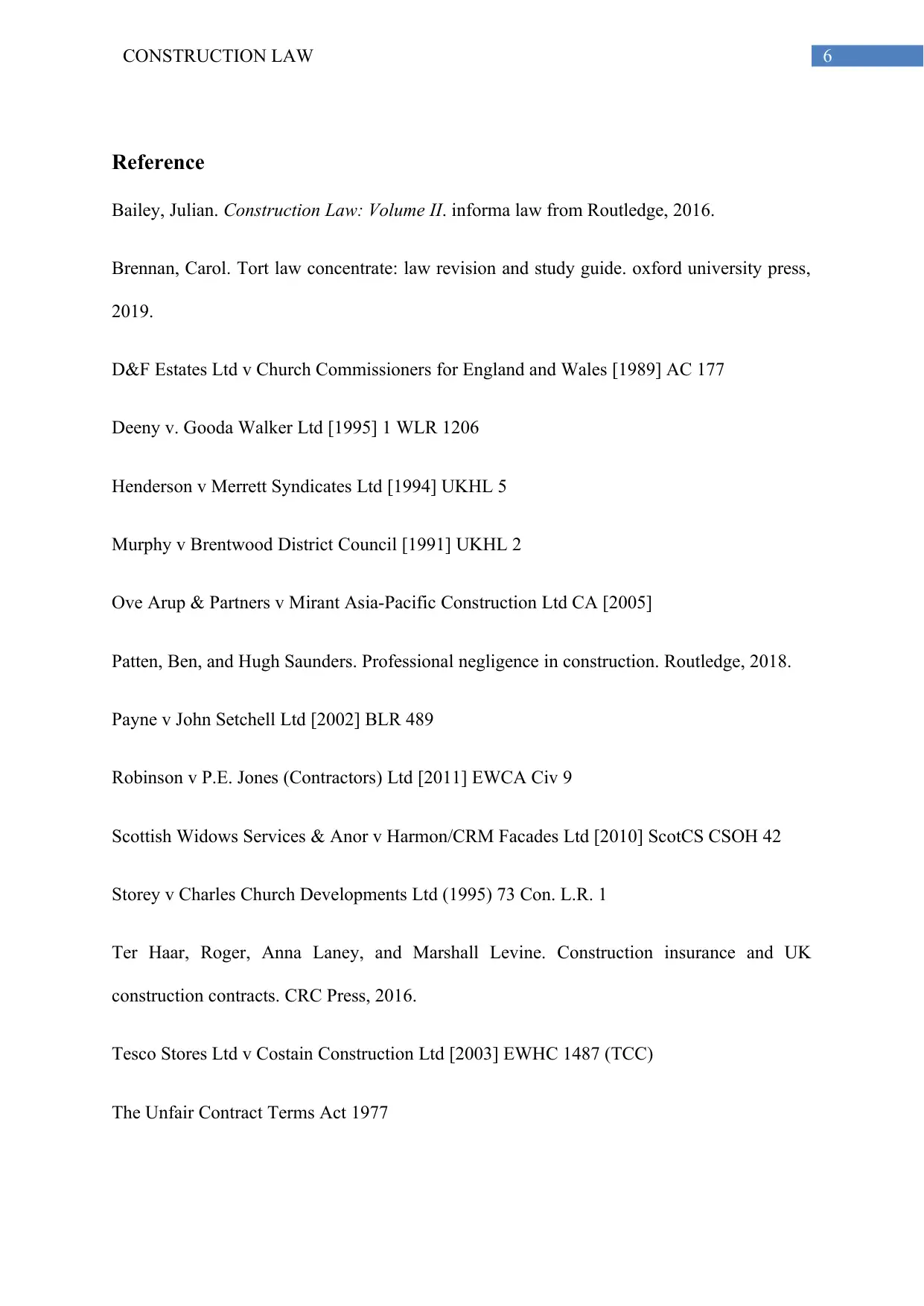
6CONSTRUCTION LAW
Reference
Bailey, Julian. Construction Law: Volume II. informa law from Routledge, 2016.
Brennan, Carol. Tort law concentrate: law revision and study guide. oxford university press,
2019.
D&F Estates Ltd v Church Commissioners for England and Wales [1989] AC 177
Deeny v. Gooda Walker Ltd [1995] 1 WLR 1206
Henderson v Merrett Syndicates Ltd [1994] UKHL 5
Murphy v Brentwood District Council [1991] UKHL 2
Ove Arup & Partners v Mirant Asia-Pacific Construction Ltd CA [2005]
Patten, Ben, and Hugh Saunders. Professional negligence in construction. Routledge, 2018.
Payne v John Setchell Ltd [2002] BLR 489
Robinson v P.E. Jones (Contractors) Ltd [2011] EWCA Civ 9
Scottish Widows Services & Anor v Harmon/CRM Facades Ltd [2010] ScotCS CSOH 42
Storey v Charles Church Developments Ltd (1995) 73 Con. L.R. 1
Ter Haar, Roger, Anna Laney, and Marshall Levine. Construction insurance and UK
construction contracts. CRC Press, 2016.
Tesco Stores Ltd v Costain Construction Ltd [2003] EWHC 1487 (TCC)
The Unfair Contract Terms Act 1977
Reference
Bailey, Julian. Construction Law: Volume II. informa law from Routledge, 2016.
Brennan, Carol. Tort law concentrate: law revision and study guide. oxford university press,
2019.
D&F Estates Ltd v Church Commissioners for England and Wales [1989] AC 177
Deeny v. Gooda Walker Ltd [1995] 1 WLR 1206
Henderson v Merrett Syndicates Ltd [1994] UKHL 5
Murphy v Brentwood District Council [1991] UKHL 2
Ove Arup & Partners v Mirant Asia-Pacific Construction Ltd CA [2005]
Patten, Ben, and Hugh Saunders. Professional negligence in construction. Routledge, 2018.
Payne v John Setchell Ltd [2002] BLR 489
Robinson v P.E. Jones (Contractors) Ltd [2011] EWCA Civ 9
Scottish Widows Services & Anor v Harmon/CRM Facades Ltd [2010] ScotCS CSOH 42
Storey v Charles Church Developments Ltd (1995) 73 Con. L.R. 1
Ter Haar, Roger, Anna Laney, and Marshall Levine. Construction insurance and UK
construction contracts. CRC Press, 2016.
Tesco Stores Ltd v Costain Construction Ltd [2003] EWHC 1487 (TCC)
The Unfair Contract Terms Act 1977
1 out of 7
Related Documents
Your All-in-One AI-Powered Toolkit for Academic Success.
+13062052269
info@desklib.com
Available 24*7 on WhatsApp / Email
![[object Object]](/_next/static/media/star-bottom.7253800d.svg)
Unlock your academic potential
Copyright © 2020–2025 A2Z Services. All Rights Reserved. Developed and managed by ZUCOL.





